The term allegory is derived from Greek and means “a story that has both a literal and a symbolic meaning.”
Allegory is a special kind of symbolism. It is a story in which the characters and events are symbols that stand for ideas about human life or for a political or historical situation. Allegory began as a popular method of teaching moral lessons hundreds of years ago because most stories were passed along orally, and readers and listeners could easily remember these stories.
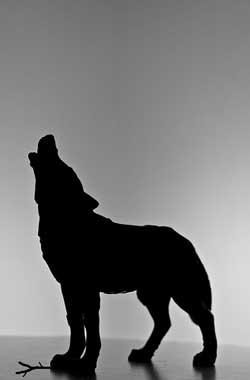
Source: Zoo:Mala Suerte Con Retratos(~March 12th 2008), ATWolf, Flickr
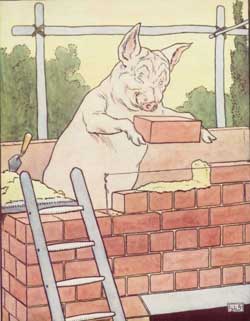
Source: Three little pigs - third pig builds a house - Project Gutenberg eText 15661, Wikimedia
In the introduction to this lesson, the story of the three little pigs was mentioned. In their story, their mother sends the pigs out into the world to make their own way. Each pig builds a house to protect himself from the dangers of the world (symbolized by the Big Bad Wolf). Pig #1 hastily constructs his house of straw, Pig #2 of sticks, and Pig #3 of brick.
The materials the pigs use have symbolic value. Straw (stalks of grain) is flimsy and probably better for making baskets than as the framework for a solid, secure house. Sticks of wood seem more durable than straw, but they are really just thin branches broken from a tree and perhaps are better suited for fuel than for creating a sturdy dwelling. The pigs who built their houses of these flimsy materials mocked their brother for laboring to build his house out of brick. Pig #3's efforts required a painstaking process of drying blocks of clay in the sun.
The result, however, was that Pig #3 built the most permanent and safe structure. When the Big Bad Wolf “huffed and puffed,” he was able to blow down the houses of straw and sticks. The first two pigs were forced to take shelter in their brother’s house with its strong brick foundation. The moral of the story is this: Hard work pays off.
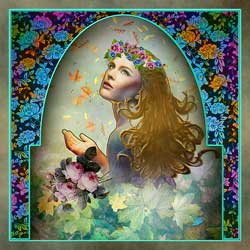
Source: Allegory, jaci XIII, Flickr
Similar to an allegorical story, an allegorical poem is one in which the characters or descriptions convey a hidden symbolic or moral message. For example, the various knights in “The Faerie Queene” by Edmund Spenser are allegorical representations of virtues such as Truth, Friendship, and Justice (often capitalized as if they were the names of particular persons). Vices may also be represented (and capitalized) in allegorical poems.
Allegorical poetry is less popular in modern literature than it was in medieval or Renaissance writing and is often found in longer poems from those periods of time.
In “The Death of Allegory,” contemporary poet Billy Collins creates an enjoyable, witty memorial to the allegorical style of writing. He pays tribute to common representations of virtues and vices in the now “dead” allegory. In the chart below, you will find the capitalized qualities or traits that Collins includes in the poem, along with synonyms for each.
| Trait | Synonyms |
|---|---|
| Truth | fact, certainty, honesty, uprightness |
| Chastity | purity, innocence |
| Courtesy | politeness, consideration, good manners |
| Villainy | wickedness, wrongdoing, evil |
| Reason | intelligence, judgment, wisdom |
| Constancy | faithfulness, dependability, single-mindedness, steadfastness, endurance |
| Valor | courage, bravery, heroism |
Allegorical elements include simile, metaphor, personification, and symbol. As you read the excerpt from the poem, pay close attention to how Collins uses these elements to create an image of each capitalized virtue or vice. “Truth,” for example, is personified as a rider “cantering on a powerful horse,” suggesting that certainty and uprightness can trot fiercely and forcefully in the world. Because the horse is often associated with war and may symbolize victory, Collins may be implying that Truth triumphed in the allegories that have died.
How does Collins depict the other capitalized virtues and vices in this excerpted version of “The Death of Allegory”? Read the poem to find out, but remember that actions, as well as objects, can be symbolic.
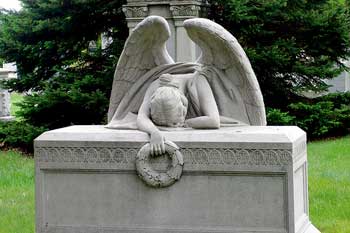
Source: sad angel, lady3jane, Flickr
The Death of Allegory
I am wondering what became of all those tall abstractions
that used to pose, robed and statuesque, in paintings
and parade about on the pages of the Renaissance
displaying their capital letters like license plates.
Truth cantering on a powerful horse,
Chastity, eyes downcast, fluttering with veils
Villainy sharpening an instrument behind a wall
Reason with her crown and Constancy alert behind a helm.
Valor lies in bed listening to the rain.
Even Death has nothing to do but mend his cloak and hood,
and all their props are locked away in a warehouse,
hourglasses, globes, blindfolds and shackles.
As for the others, the great ideas on horseback
and the long-haired virtues in embroidered gowns,
it looks as though they have traveled down
the road you see on the final page of storybooks,
the one that winds up a green hillside and disappears
into an unseen valley where everyone must be fast asleep.
In the exercise that follows, answer the questions about this poem and the symbolic meanings Collins incorporates. Click on one answer for each question that appears.


Source: Happily Ever After, Josh Clark, Flickr
Although Collins seems to regret the “death of allegory,” he gives the poem a somewhat positive ending. In the last stanza, he alludes to a fairy-tale, happy ending when he describes the allegorical virtues and vices completing their journey on “that road that you see on the final page of storybooks.” The road “winds up a green hillside.” The color green signifies growth and renewal. The poem also ends in a “valley,” often a symbol of fertility and life.
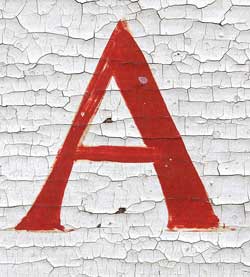
Source: A, chrisinplymouth, Flickr
Like symbolism, allegory transfers and broadens meaning in a text. Both strategies (symbolism and allegory) contribute to mood and theme in literature. It is important that you pay attention to them.
In this lesson, you have learned that symbols are concrete objects that can be used to represent abstract ideas. Some abstract ideas require more explaining than others. In the nineteenth-century novel The Scarlet Letter, Nathaniel Hawthorne devotes several paragraphs to the description of the red letter A that Hester Prynne is sentenced to wear as a symbol of her sin.
In poetry and other literature, if words or actions appear frequently, they may be symbols. Learning to recognize symbols when you read is important.